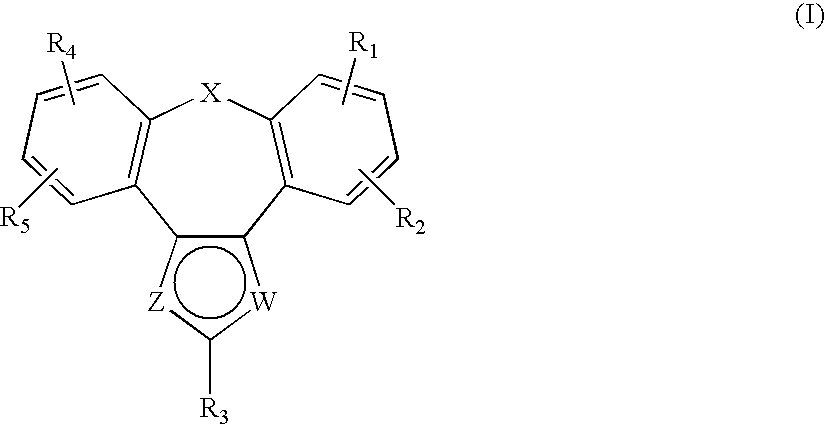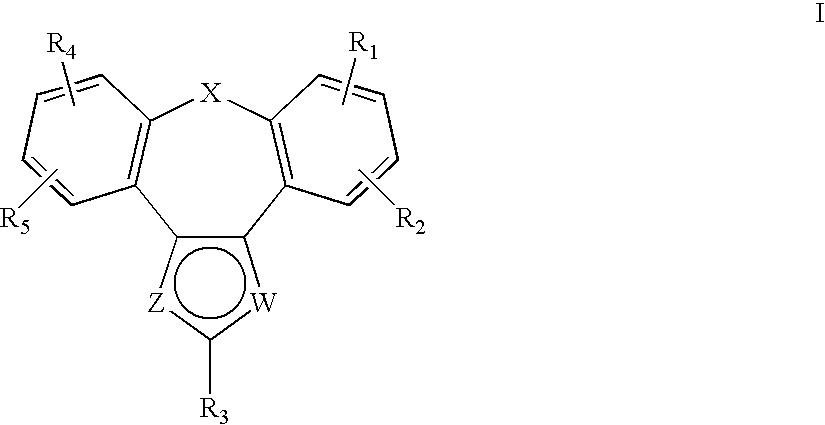Tetracyclic Monoamine Reuptake Inhibitors for Treatment of Cns Diseases and Disorders
a technology of tetracyclic monoamine and reuptake inhibitor, which is applied in the direction of biocide, plant growth regulator, animal husbandry, etc., can solve the problems of delayed onset of action, high incidence of sexual dysfunction, and limited efficacy
- Summary
- Abstract
- Description
- Claims
- Application Information
AI Technical Summary
Benefits of technology
Problems solved by technology
Method used
Image
Examples
preparation examples
[0171]The present invention is illustrated by the following Examples, which in no way represent a limitation thereof.
Intermediate 1: [2-(4-chloro-2-methoxyphenoxy)phenyl]acetic acid
[0172]A reaction mixture of 4-chloro-2-methoxyphenol (6.31 mmol), (2-chlorophenyl)acetic acid (6.31 mmol), cooper (I) chloride (0.63 mmol), potassium carbonate (9.47 mmol) and xylene (10.0 mL) was heated under reflux for 7 hours, and then was cooled to room temperature, diluted with water and extracted with ethyl acetate. The organic extract was washed with an aqueous potassium carbonate solution. Water extracts were acidified with conc. hydrochloric acid, and then extracted with ethyl acetate. The organic extract was washed with an aqueous sodium chloride solution, dried over anhydrous Na2SO4 and evaporated under reduce pressure to yield the title compound as a solid product. 1H NMR (ppm, CDCl3): 12.37 (bs, 1H), 7.46-6.58 (m, 7H), 3.78 (s, 3H), 3.63 (s, 2H).
Intermediate 2: 8-Chloro-6-methoxy-11H-dibenzo[...
example 1
11-Chloro-9-(3-dimethylaminopropoxy)-8-oxa-1-thia-dibenzo[e,h]azulene-2-carboxylic acid ethyl ester
[0177]Potassium carbonate (0.56 mmole) was added to a solution of Intermediate 5 (0.22 mmol) in 1N,N′-dimethylformamide (3.0 mL). The reaction mixture was heated to 100° C. and 3-dimethylaminopropylchloride hydrochloride (0.27 mmol) was added. The reaction mixture was stirred for 4 hours at 100° C., and then cooled to room temperature and evaporated under reduce pressure. After evaporation, water was added to the residue and the resultant mixture was extracted with ethyl acetate. The organic extract was washed with aqueous hydrochloric acid and sodium chloride solutions, dried over anhydrous Na2SO4 and evaporated under reduce pressure. After purification of the evaporated residue by chromatography on a silica gel column, a solid product was isolated. 1H NMR (ppm, CDCl3): 8.03 (s, 1H), 7.53-6.98 (m, 6H), 4.41 (q, 2H), 4.14 (t, 2H), 2.72 (t, 2H), 2.42 (s, 6H), 2.20 (qn, 2H), 1.42 (t, 3H)...
example 2
11-Chloro-9-(3-dimethylamino-propoxy)-8-oxa-1-thia-dibenzo[e,h]azulene-2-carboxylic acid ethyl ester citrate salt
[0178]To a stirred ethanol solution of Example 1 (0.25 g, 0.546 mmol in 5 mL of ethanol), previously cooled at 0° C., an ethanol solution of citric acid was dropped (0.1146 g, 0.546 mmol in 5 mL of ethanol). When addition of citric acid was completed, ethanol was evaporated to yield a light yellow solid product (0.27 g); MS (m / z, ES+): 458 [MH]+; m.p. 80-87° C.; pKa 6.90; logP 4.5; solubility (S) 167 mg / mL (at 25° C. and ionic strength 0.15 M).
PUM
 Login to View More
Login to View More Abstract
Description
Claims
Application Information
 Login to View More
Login to View More - R&D
- Intellectual Property
- Life Sciences
- Materials
- Tech Scout
- Unparalleled Data Quality
- Higher Quality Content
- 60% Fewer Hallucinations
Browse by: Latest US Patents, China's latest patents, Technical Efficacy Thesaurus, Application Domain, Technology Topic, Popular Technical Reports.
© 2025 PatSnap. All rights reserved.Legal|Privacy policy|Modern Slavery Act Transparency Statement|Sitemap|About US| Contact US: help@patsnap.com



